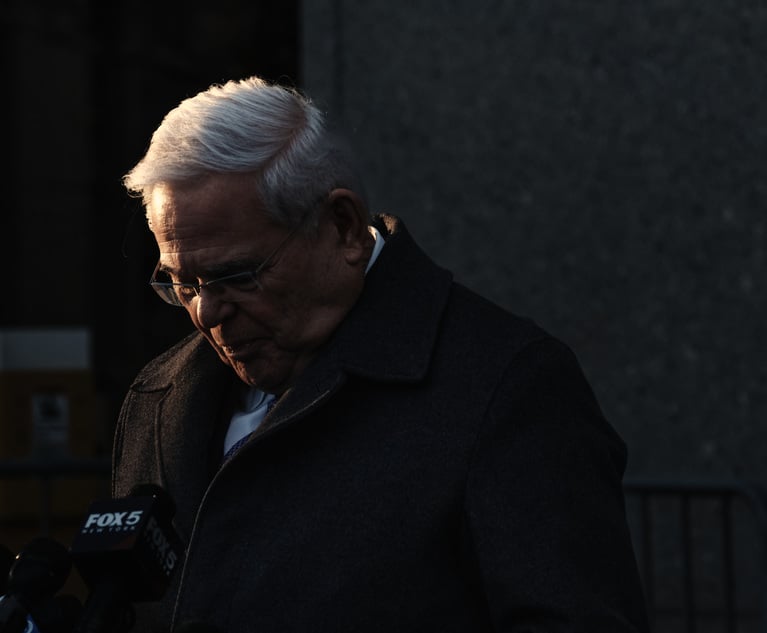 Photo: Stephen Fore via Adobe Stock
Photo: Stephen Fore via Adobe StockWhen Does Reckless Driving Qualify as Criminal Homicide?
What criteria is necessary for reckless driving to be considered criminal? Judge Louis Locascio provides insight.
November 13, 2024 at 11:30 AM
5 minute read
Can reckless driving be considered criminal?
Yes, said the court, if defendant consciously disregards a substantial and unjustifiable risk which amounts to “a gross deviation from the way a reasonable person would have conducted himself in the situation.” State v. Huang, 240 N.J. 56 (2019).
On Jan. 16, 2016, defendant and his passenger had finished dinner at a Chinese restaurant located in a strip mall adjacent to Route 27, Highland Park, New Jersey. As defendant exited the parking lot, he failed to properly execute a full left turn. Specifically, without ever applying his brakes, he crossed four lanes, mounted the curb on the opposite side of Route 27, then sheared two metal signs and hit a concrete planter. He continued on and recrossed the four lanes and crashed into a tree. The evidence also showed that in 4.65 seconds defendant reached a speed of 37.3 miles per hour, that defendant “enjoyed the feeling of acceleration to the point of feeling his back pushed against the seat.”
One of the street sign support posts struck a six-year-old child in the head, which resulted in his untimely death. Defendant was subsequently indicted for second degree vehicular homicide of a child. N.J.S.A. 2C:11-5(a).
The trial court granted defendant’s motion to dismiss the indictment. The Appellate Division reversed and remanded, with Judge Jose Fuentes dissenting. 461 N.J. Super. 119 (App. Div. 2018). The Supreme Court, per curiam, 240 N.J. 56 (2019), affirmed substantially for the reasons expressed in Judge Scott Moynihan’s Appellate Division majority opinion.
The evidence presented to the grand jury included defendant’s medical records in which his doctor opined that at the time of the incident, defendant suffered from a “basilar artery migraine causing the warning symptoms of dizziness, whiting out of vision, then loss of consciousness” possibly caused by defendant’s “consuming MSG at a Chinese restaurant.”
Defendant was indicted for second degree vehicular homicide, N.J.S.A. 2C:11-5(a) which “is caused by driving a vehicle … recklessly”. Recklessly is defined as when a driver “consciously disregards a substantial and unjustifiable risk [which] … considering the nature and purpose of the actor’s conduct and the circumstances known to him, its disregard involves a gross deviation from the standard of conduct that a reasonable person would observe in the actor’s situation.” N.J.S.A.2C:2-2(b)(3).
In reversing the trial court’s dismissal of the indictment, the Appellate Division pointed out that the criminal homicide statute creates an inference of recklessness if defendant:
- Fell asleep while driving having not previously slept for 24 hours;
- Was intoxicated;
- Was on a handheld phone; or
- Failed to maintain a lane of travel.
In his dissent, Fuentes, pointed out that none of the inferences of recklessness enumerated in N.J.S.A. 2C:11-15(a) were present in this case. Specifically, the evidence demonstrated that defendant:
- Was not sleep deprived;
- Was not intoxicated;
- Was not on a cell phone; and
- At the time of the accident defendant was travelling at 37.6 miles per hour in a 40 mile per hour zone, i.e., under the speed limit.
Fuentes stated that the testimony about defendant’s “alleged predilection for acceleration … was highly prejudicial and would have been palpably inadmissible in a future trial under N.J.R.E. 404(b) because it was clearly offered by the state to prove the disposition of a person in order to show that such person acted in conformity therewith.” Fuentes considered this tactic by the state to be “patently inconsistent with basic principles of fundamental fairness.”
Thus, Fuentes concluded that “viewed in the light most favorable to the state, this tragic occurrence bespeaks of civil negligence, not criminal recklessness.”
In this author’s opinion, Moynihan clearly got it right. In addition to being entitled to an inference of recklessness because the defendant not only failed to maintain a lane of travel, here defendant failed to maintain eight lanes of travel. Additionally, defendant sheared two street signs, struck a planter, and crashed into a tree. Even Fuentes, in his dissent, concedes that defendant’s conduct “bespeaks of civil negligence, not criminal recklessness.” Thus, it would appear that even the dissent agrees that defendant’s conduct constituted a negligent deviation from the standard of conduct that a reasonable person would observe in defendant’s situation, but contends it was not a gross deviation. In this author’s opinion such a distinction is simply a matter of degree which clearly is a question of fact for a jury, not a judge, to decide.
Louis F. Locascio, a Monmouth County Superior Court Judge from 1992 until 2009, is now of counsel with The Law Office of Andrew S. Blumer in Freehold, where he heads up the mediation/arbitration department.
NOT FOR REPRINT
© 2025 ALM Global, LLC, All Rights Reserved. Request academic re-use from www.copyright.com. All other uses, submit a request to [email protected]. For more information visit Asset & Logo Licensing.
You Might Like
View All

'You Became a Corrupt Politician': Judge Gives Prison Time to Former Sen. Robert Menendez for Corruption Conviction
5 minute read
‘The Decision Will Help Others’: NJ Supreme Court Reverses Appellate Div. in OPRA Claim Over Body-Worn Camera Footage
5 minute read
Trending Stories
- 1Uber Files RICO Suit Against Plaintiff-Side Firms Alleging Fraudulent Injury Claims
- 2The Law Firm Disrupted: Scrutinizing the Elephant More Than the Mouse
- 3Inherent Diminished Value Damages Unavailable to 3rd-Party Claimants, Court Says
- 4Pa. Defense Firm Sued by Client Over Ex-Eagles Player's $43.5M Med Mal Win
- 5Losses Mount at Morris Manning, but Departing Ex-Chair Stays Bullish About His Old Firm's Future
Who Got The Work
J. Brugh Lower of Gibbons has entered an appearance for industrial equipment supplier Devco Corporation in a pending trademark infringement lawsuit. The suit, accusing the defendant of selling knock-off Graco products, was filed Dec. 18 in New Jersey District Court by Rivkin Radler on behalf of Graco Inc. and Graco Minnesota. The case, assigned to U.S. District Judge Zahid N. Quraishi, is 3:24-cv-11294, Graco Inc. et al v. Devco Corporation.
Who Got The Work
Rebecca Maller-Stein and Kent A. Yalowitz of Arnold & Porter Kaye Scholer have entered their appearances for Hanaco Venture Capital and its executives, Lior Prosor and David Frankel, in a pending securities lawsuit. The action, filed on Dec. 24 in New York Southern District Court by Zell, Aron & Co. on behalf of Goldeneye Advisors, accuses the defendants of negligently and fraudulently managing the plaintiff's $1 million investment. The case, assigned to U.S. District Judge Vernon S. Broderick, is 1:24-cv-09918, Goldeneye Advisors, LLC v. Hanaco Venture Capital, Ltd. et al.
Who Got The Work
Attorneys from A&O Shearman has stepped in as defense counsel for Toronto-Dominion Bank and other defendants in a pending securities class action. The suit, filed Dec. 11 in New York Southern District Court by Bleichmar Fonti & Auld, accuses the defendants of concealing the bank's 'pervasive' deficiencies in regards to its compliance with the Bank Secrecy Act and the quality of its anti-money laundering controls. The case, assigned to U.S. District Judge Arun Subramanian, is 1:24-cv-09445, Gonzalez v. The Toronto-Dominion Bank et al.
Who Got The Work
Crown Castle International, a Pennsylvania company providing shared communications infrastructure, has turned to Luke D. Wolf of Gordon Rees Scully Mansukhani to fend off a pending breach-of-contract lawsuit. The court action, filed Nov. 25 in Michigan Eastern District Court by Hooper Hathaway PC on behalf of The Town Residences LLC, accuses Crown Castle of failing to transfer approximately $30,000 in utility payments from T-Mobile in breach of a roof-top lease and assignment agreement. The case, assigned to U.S. District Judge Susan K. Declercq, is 2:24-cv-13131, The Town Residences LLC v. T-Mobile US, Inc. et al.
Who Got The Work
Wilfred P. Coronato and Daniel M. Schwartz of McCarter & English have stepped in as defense counsel to Electrolux Home Products Inc. in a pending product liability lawsuit. The court action, filed Nov. 26 in New York Eastern District Court by Poulos Lopiccolo PC and Nagel Rice LLP on behalf of David Stern, alleges that the defendant's refrigerators’ drawers and shelving repeatedly break and fall apart within months after purchase. The case, assigned to U.S. District Judge Joan M. Azrack, is 2:24-cv-08204, Stern v. Electrolux Home Products, Inc.
Featured Firms
Law Offices of Gary Martin Hays & Associates, P.C.
(470) 294-1674
Law Offices of Mark E. Salomone
(857) 444-6468
Smith & Hassler
(713) 739-1250






